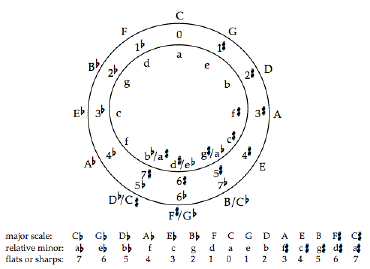Answer: The circle of fifths is a pedagogical device that illustrates the order in which key signatures add flats or sharps. It could as easily be drawn in a straight line, actually. Starting with C major the key signature has no sharps or flats. Go up one perfect fifth to G and the key of G major has one sharp. For each fifth you ascend from C another sharp is added to the key signature: D major has 2 sharps, A has 3, etc. When you reach C#, though, you need to stop because you now have seven sharps and that's as far as we go. In the other direction, go down a fifth from C and the major key on that note, F, has one flat. Another perfect fifth downward brings you to Bb major, which has two flats, and so on as before: Eb has 3, Ab has 4, etc. The downward direction ends at Cb with 7 flats.
tonic note: Cb Gb Db Ab Eb Bb F C G D A E B F# C#
key signature: 7b 6b 5b 4b 3b 2b 1b 1# 2# 3# 4# 5# 6# 7#
If you bend that chart into a circle you can overlap the last few in each direction: Db, with 5 flats, is enharmonically equivalent to C#, with 7 sharps, for example (that is, the two notes are on the same piano key but have different names). Gb is equivalent to F# and Bb is equivalent to A#. If the keyboard were to be tuned unequally these would not really be equivalent, and then the circle would have to be more of a spiral. But with the octave tuned in 12 equal steps as it is on modern instruments, the "enharmonic equivalents" sound exactly the same.
To remember the key signature for the major key on any tonic, count the perfect fifths from C to that note, ascending or descending.
From that you can also tell the key signature for the minor key of the same name: every minor key uses the key signature for the major key one minor third up. So A minor uses the C major key signature; D minor uses the F major signature, and so on. On the circle (or line as above) you can count left three steps (3 fifths) and that gets you to the same place: B minor will use the same key signature as D major.
The circle is therefore a list of tonics - the starting notes of all possible major scales - and their appropriate key signatures. The tonic of each scale is of course the root tone of the tonic triad for that key. The octave doesn't matter; this principle holds true for all octaves. Here's what the circle looks like in Exploring Theory with Practica Musica, with the minor keys included in an inner circle:


